Kyoto Imperial Palace and other Imperial Palaces and Villas in Kyoto
Kyoto Imperial Palace
| Photo | Description |
|---|---|
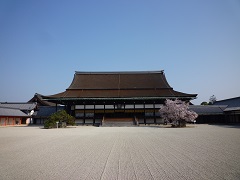 Shishinden (Hall for State Ceremonies)
(Photo: Imperial Household Agency) |
The city of Kyoto was home to the Imperial Residence since the relocation of the capital by Emperor Kanmu in 794. The present Kyoto Imperial Palace had been used as the residence of Emperors for 500 years since 1331 until the capital moved to Tokyo in 1869. The palace was repeatedly plagued by fire and was rebuilt each time. Most of the present buildings were rebuilt in 1855. One can observe the transition of the architectural style through the buildings that encompass features of multiple eras from the 8th century. Among them, the most prestigious building is the Shishinden (Hall for State Ceremonies). The building was constructed in the architectural style of the Heian Period (794-1185) to accommodate the Enthronement Ceremony which was held in traditional manners. The Enthronement Ceremonies of Emperors Meiji, Taishō, and Shōwa were held in the present hall and the Takamikura Imperial Throne for the Emperor and Michodai August Seat of the Empress used for the ceremony are placed inside. Presently, some of the important court events such as the Kyoto Imperial Palace Tea Party hosted by Their Majesties the Emperor and the Empress sometimes are celebrated here. The palace also receives state guests and plays an important role as a place that introduces Japanese court culture to foreign dignitaries. On the palace grounds, besides the palace buildings, are two gardens. The Pond Garden is a stroll garden and the Inner garden has variously styled stone lanterns and arrangements presented by some prominent feudal lords. The gardens’seasonal changes of flowers and trees are a delight for the eye. Map of the Kyoto Imperial Palace(Opens in a new window) Visit Guide (Application for the Imperial Palaces in Tokyo and Kyoto)(Opens in a new window) |
Kyoto Omiya Imperial Palace・Kyoto Sento Imperial Palace
| Photo | Description |
|---|---|
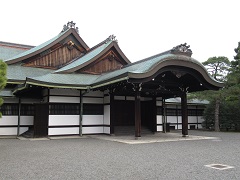 Kyoto Omiya Imperial Palace
(Photo:Imperial Household Agency) 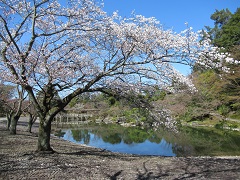 Suhama Shore(South Pond)
(Photo:Imperial Household Agency) |
Kyoto Omiya Imperial Palace Kyoto Sento Imperial Palace 'Sento Palace’ means the residence for the Emperor Emeritus, and ‘Omiya Palace’ means the one for his consort, the Empress Emerita. In 1630, these two residences were built at the present site which is adjacent to the Kyoto Imperial Palace for Emperor Emeritus Gomizuno-o and his consort. Destroyed repeatedly by fire, the buildings were rebuilt each time. The last major fire, which occurred in 1854, burned down all the main buildings. In 1867, Omiya Palace was rebuilt and presently it is used an accommodation facility for Their Majesties the Emperor and Empress. The main building of Sento Palace has not been rebuilt. Its elegant garden contains two large ponds and two tea house pavilions. The garden path leads around the North Pond and crosses the canal connecting the North and South Ponds by an earthen bridge, and leads around the South Pond. The South Pond is known as its graceful bank lined with flat oval pebbles. In spring, cherry blossoms, wisteria trellis and azaleas can be enjoyed. In autumn, the garden is ablaze with autumn leaves. Map of the Kyoto Omiya Imperial Palace & Kyoto Sento Imperial Palace(Opens in a new window) Visit Guide (Application for the Imperial Palaces in Tokyo and Kyoto)(Opens in a new window) |
Katsura Imperial Villa
| Photo | Description |
|---|---|
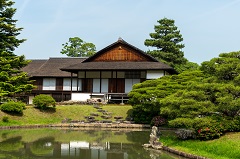 Shoin(Palace)
(Photo:Imperial Household Agency) |
The Katsura Imperial Villa is located on the west side of the Katsura River in the southwestern area of the city of Kyoto. It was built in stages over a period of almost 50 years from 1615 by the first two heads of the Hachijō-no-miya Imperial family, prince Toshihito, and his son, prince Toshitada. The prince had a profound knowledge of classic literature. He chose the land of Katsura because it was described in‘The Tale of Genji’ written in the Heian Period (794-1185). Being saved from the damage of fire, the buildings retain their original form to the present day. The compound incorporates a large pond which dominates the center of the garden, the palace building and four tea house pavilions. The pond’s shape is irregular so that the garden path along the shoreline frequently twists and turns. As this garden design blocks one from seeing too much of the garden at one time, one could enjoy a constantly changing view. The garden is also known for seasonal flowers such as Japanese apricot in early spring, cherry blossoms, and crimson flowers of azalea in late spring. Map of the Katsura Imperial Villa(Opens in a new window) Visit Guide (Application for the Imperial Palaces in Tokyo and Kyoto)(Opens in a new window) |
Shugakuin Imperial Villa
| Photo | Description |
|---|---|
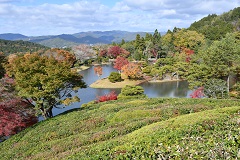 Yokuryuchi(Pond in the Upper Villa)
(Photo:Imperial Household Agency) |
The Shugakuin Imperial Villa is located on the slope of Mount Hiei in the northeastern area of Kyoto city. Emperor Emeritus Gomizuno-o constructed this villa over four years from 1656 to 1659. The estate incorporates three different plateaus named Upper Villa, Middle Villa, and Lower Villa, each with its own building and garden, as well as paddy fields. A graveled path lined with pine trees crosses over the paddy fields and connects the three villas. In the Lower Villa, a mountain range around the villa is incorporated as a backdrop of the garden. This gardening method is called Shakkei (borrowed landscapes), which incorporates outside scenery into the garden’s landscape to provide more three dimensional effect to the view of the garden. The Kyakuden pavilion situated in the Middle villa contains Kasumidana(a set of staggered shelves) which was considered to be a novel design in those days. From the Rinuntei Pavilion situated at the highest level in the Upper Villa, one can enjoy the dramatic panorama of the pond called Yokuryūchi, which was formed by damming water flowing down the mountains, with the view of the whole city of Kyoto below and the western mountains on the far side. In spring, the garden is brightly colored with cherry blossoms, flowers of azalea and rhododendron. In autumn, the spectacle of the surrounding mountains covered with vivid autumn leaves can be enjoyed. Map of the Shugakuin Imperial Villa(Opens in a new window) Visit Guide (Application for the Imperial Palaces in Tokyo and Kyoto)(Opens in a new window) |